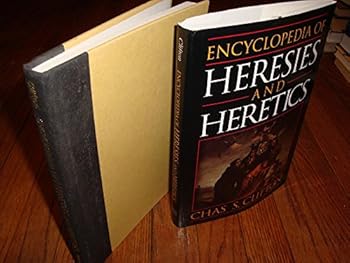Encyclopedia of Heresies and Heretics
Select Format
Select Condition 
Book Overview
Examines the various heretic movements and individuals throughout Christian history, from the time of Christ's crucifixion to the 16th century. This description may be from another edition of this product.
Format:Hardcover
Language:English
ISBN:0760708231
ISBN13:9780760708231
Release Date:January 1998
Publisher:Barnes & Noble Books
Length:156 Pages
Weight:1.24 lbs.
Customer Reviews
4 ratings
Good Material on Heresies
Published by Thriftbooks.com User , 15 years ago
A very good introduction to Heresies in the Christian Religion. The coverage is designed for the average reader, so those interested in specific heeresies, and desiring detials of their development will find this book lacking. However, it is designed to suit those looking for an overview, not the specialist. It fills that need very well indeed. I reccomend it for its general interest. The specialis might gain a broader view by reading it as well.
A fun and wonderful, fascinating collection of information on 'heretical' groups and individuals
Published by Thriftbooks.com User , 18 years ago
This book is crammed full of different 'heresies' and colorful figures of history. I'm particularly impressed with its scope. An excellent, fun read. A great way to find an intriguing piece of history, a strange idea, that can be pursued and studied in more depth. Can lead the reader on a historical journey into the alternative, the fringe, the inspired. With a bit of detective work, following some of the leads given here, all kinds of doors open to the reader.
GNOSTICISM 101
Published by Thriftbooks.com User , 20 years ago
This is by far the best introduction to pre-christian theology, gnosticism, et al, that I've seen. It sets the stage for those who understand the dynamics of the drama which inevitably follows...
short but sweet, good starting point on religion
Published by Thriftbooks.com User , 20 years ago
This book, "Encyclopedia of Heresies and Heretics" is a weird little tome. But a very good fine little bit of weirdness. First, it is not as much an all-encompassing book about Christian Heretics and Heresies, as a catalog of major European ones from the Dark and Middle Ages. Christianity have changed and evolved over the years to include and exclude odd-groups of people at times. Where the author has the most difficulty is in nailing-down what the, in many cases, now eliminated sect actually believed in. This is where some of it gets real hazy, because often the groups that may have had similar surface beliefs but gotten them from radically different sources. A good example of this is probably in two major dualistic sects of: the Italian Cathari movement and the southern French Albigensians. Both became rather large minorities within greater Catholicism, but the Albigensians probably had, at its most inner core, a heart of Manichaeism (another religion that was a very early competitor to Christianity, St. Augustine at an early part of his life had been one), where as the Cathar movement was more a back-to-basics purity movement, probably influenced by a very early form of Christianity called Gnosticism. They get confused for each other because they worked together against what they saw as their common enemy: the Roman Catholic officialdom. And then there was the Eastern Bogomils as well, also with similar surface beliefs. They probably helped give rise to the Cathari in Italy... but, how close where they in core basic belief... well... we can't be positively sure.At issue, lets think of it this way... Modern forms of Christianity: Orthodoxy, Catholicism and Protestantism all share some very basic beliefs, but also have some very large disagreements amongst themselves. Outsides often have trouble figuring out what surface disagreements and what are core disagreements. Well, looking at the various heresies of the past, we may have trouble noticing core disagreements because, in practice, they often cooperated with each other, and looked and acted much the same. It also does help that those who fought against them often couldn't seem to tell the difference themselves. Of course, there is the added problem that most of the writings the various groups may have had were destroyed by the Catholic higharcy that, in the end, suppressed them. So, what is left often is either what the oppressors either missed or thought didn't matter. It is material that may not represent a true cross section of what the groups truly believed. The book provides a good introduction to the various topics. He covers the major European topics. There are some over sights; he doesn't mention either Zoroastrism or Islam. He covers Mani and Manichaeism, but doesn't really discuss its roots in Zoroastrism. Also, Islam had a big affect on Christianity in many ways and places. There were some weird sects that tried to combine aspects of Islam and Christianity in






